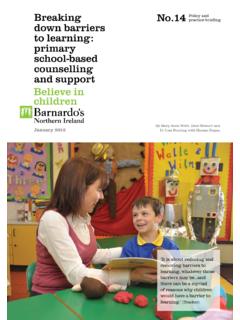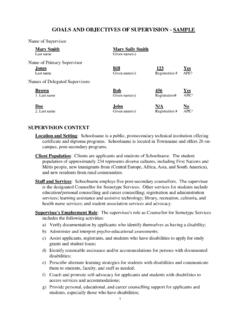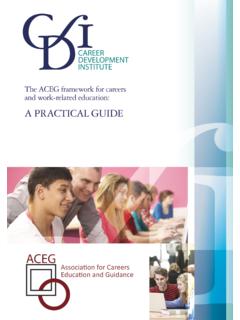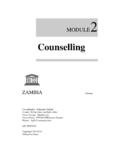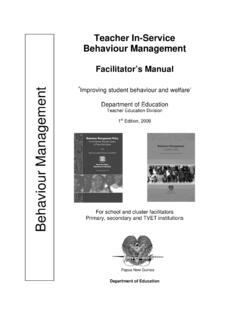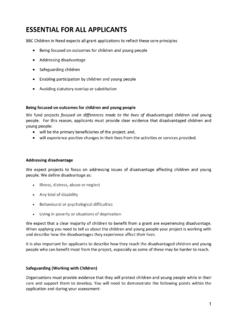Transcription of Effective Career Guidance
1 221 Effective Career GuidanceCareer Guide for SchoolsReport on Effective Career GuidanceArtwork:Giannis TsiapisEditor:Nora GikopoulouCareerGuide network is carried out within the framework of the Socrates/Comenius 3 and is co-financed by the European CommissionContact Number:225936-CP-1-12005-1-GR - COMENIOUS - C3 PPCopyright 2008 Career GuideAll rights or translation of any part of this work without the written permission of the copyright owners is unlawful. Request for permission or further information should be addressed to the copyright by EPINOIA Guidance Theories ..7 Matching Theories (Trait/factor) ..81. Introduction ..82. Seven Point Plan ..83. Hierarchy of Orientations ..94. Implications for practice ..105. Critiques ..10 References ..12developmental theory ..141. Introduction ..142. Eli Ginzberg ..143. Donald Super ..144. Criticisms ..16 Theory of occupational allocation (opportunity structure) ..18 Uncertain Destinations & Risk.
2 20 Life course replaces life cycle ..21 Conclusion ..21 References ..22 Learning theory of careers choice & counselling ..231. Social learning theory of Career decision-making (sltcdm) ..232. Learning theory of careers choice & counselling ..263. Happenstance in vocational & educational Guidance ..29 References: ..30 Psychodynamic theories ..321. Anne Mark Savickas ..333. Conclusion ..34 References ..34 Community interaction theory ..36 References ..37 Career Guidance sTaTus in euroPe ..381. Institutions/Organizations ..392. Methods in Use ..623. Limitations ..774. Tools and Systems ..825. Games ..93 Career Guide For sChooLs ProjeCT s MeThodoLoGies and aPProaChes ..100aCTiviTies and exerCises ..106 Thematic area 1: Find out about yourself ..107 Boosting Your Self-Esteem ..107 References ..109 Iceberg s exercise ..109 VAK (Visual-auditory-kinesthetic) learning style indicators ..115 Personal Development plans ..118A different identity card.
3 129I am ..131 Decision Making ..132 Decisions! Decisions! ..136 Playing the residence constructor ..141 SNIP Analysis ..144 Personal skills and qualities ..147 Thomas Edison s story ..151 Activity concerning setting goals and professional values ..153 References ..156 First steps with the five elements ..156 Thematic area 2: Know about job Market ..159De stereotyping job titles ..159 Key skills in different jobs ..163 Marketable and not marketable professions in Greece ..187 Essential Tips for your Job Hunt ..195 Thematic area 3: develop yourself for your Career Path ..198CV writing tips and advice ..198 How to write a covering letter ..206 The Europass Cv template ..208 Seven principles of good communication ..212 Presentation Skills ..214 The EIS Simulation as an aid to Career Guidance in Schools ..215effective Career GuidanceIntroductionThe Effective Career Guidance handbook is the final product of the European network CareerGuide For Schools ( ) It is a practical tool which includes the main theories of the Career Guidance , new approaches and exercises and activities for Career Guidance in school .
4 The main aim is to provide to teacher or counsellor a practical manual with exercises and activities detailed described, with a theoretical framework and the expected results, to provide a step by step process of Career Guidance with material which will be easily implemented in classroom and students the exercises have been implemented and evaluated by teachers and counsellors from different countries through Europe. It is a fact that some activities had different evaluation in different countries. It is normal and expected result, as far the educational systems, the aims, procedures and the culture are different in each CareerGUIDE Materials were provided for download in the Career Guide Forum ( ). For each material the forum contained a thread including the English version of the material and additional translations in several of the project partner Gikopoulou7 Effective Career GuidanceCareer Guidance Theories8 Effective Career GuidanceMatching Theories (Trait/factor)Based on differential psychology, these approaches assume that Guidance is essentially about a process of rational decision making in which clients are assessed by the expert pracitioner and then matched to the best fit opportunity.
5 It follows that the provision of information about the client and the world of work will result in behaviour change ( improved decision making skills). 1. introductionParsons (1908) is regarded as the founder of the vocational Guidance movement. He devel-oped the `talent matching approach which was subsequently developed into the trait and factor theory of occupational choice within the evolving discipline of differential psychology. Parsons core concept was that of `matching . He suggested that occupational choice oc-curs when people have achieved: first, an accurate understanding of their individual traits ( personal abilities, aptitudes, interests, etc.); second, a knowledge of jobs and the labour market; and third, made a rational and objective judgement about the relationship between these two groups of facts. A key assumption is that it is possible to measure both individual talents and the attributes required in particular jobs, which can then be matched to achieve a `good fit.
6 It is when individuals are in jobs best suited to their abilities, they perform best and productivity is highest. Two theorists within this broad academic tradition, Rodgers and Holland, have been par-ticularly influential so far as Guidance practice in the UK is concerned. Like Parsons, both Rodgers and Holland assumed that matching is at the centre of the process. Vocational choice is viewed essentially as rational and largely devoid of emotions. These choices were also regarded to be `one-off events. 2. seven Point PlanIn 1952, Alec Rodger published his `Seven Point Plan . Originally devised for use in selec-tion interviews, the plan was enthusiastically embraced by Guidance trainers and practition-ers as a useful model to inform practice. It consists of seven attributes: physical charac-teristics, attainments, general intelligence, specialised aptitudes, interests, disposition and 9 Effective Career Guidancecircumstances. Application of this plan to Guidance practice involves first, an evaluation of jobs against these seven attributes; second, assessment of an individual client against these seven attributes to ascertain the extent to which the client is a `good fit.
7 Only when there is an acceptable match of the two sets of attributes can a recommendation be made by the Guidance practitioner to the client that this is an area worth pursuing. This framework has been used in a number of ways in Guidance practice. For example, to assess whether client aspirations for a particular job or Career are realistic when reviewed against actual achievements or potential; to generate job ideas for a client who had few or no job ideas; and to analyse jobs, employment and training opportunities. 3. hierarchy of orientationsWorking within the same philosophical tradition, Holland (1966, 1973, 1985, 1992) devel-oped an occupational classification system that categorises personalities and environments into six model types: realistic, investigative, artistic, social, enterprising and conventional. His ideas still fall broadly within the matching tradition established by Parsons (1908), since he proposed: first, that each of his six personality types are related to need and individuals can be categorised in one (or more) of these types; second, that work environments can also be classified in this way; third that vocational choice involves individuals searching for work environments that are congruent with their personality type.
8 Subsequent developments of his theory place more emphasis on the interaction of the in-dividual with their environment and the influence of heredity (Holland, 1985, 1992). Holland (1994) noted how he had been renovating the internal structure of [his] own theory (Hol-land, 1992) to give it more explanatory power . He referred specifically to the way in which he had elaborated his typology to include life goals, values, self-beliefs and problem-solving styles, and how the developmental nature of types over the life-span is now incorporated (Holland, 1994). Osipow & Fitzgerald (1996) consider Holland s study of vocational selection and behaviour to be very comprehensive, within his theoretical framework. They verify how extensive in-vestigations and modifications to the original ideas have been undertaken, yet the theory remained fundamentally unchanged (Osipow & Fitzgerald, 1996, ). On the 40th an-niversary of Holland s first theoretical statement, the Journal of Vocational Behaviour docu-mented the progression and development of his ideas.
9 In the introduction to this festschrift, Savickas (1999) describes Holland s contribution as a surpassing ach ievement in vo-cational psychology Continuing this theme, Gottfredson (1999) describes how Holland s 10 Effective Career Guidance monumental research, theoretical, and practical contributions have irrevocably altered the manner in which Career assistance is delivered around the world . It seems unquestionable, therefore, that Holland s ideas have had, and continue to have, a major impact. 4. implications for practiceUndoubtedly, trait and factor approaches to careers Guidance in the UK have been enor-mously influential, since they were first developed up to the present day. How can we ac-count for this? The dominant influence of differential approaches on the practice of careers Guidance in the UK can be explained, partly, by their practical appeal. They provide careers practitioners with a clear rationale and framework for practice.
10 Their role is clearly defined as `expert , with the specialist knowledge about the labour market as well as with the methods to assess individual suitability and capability for the labour market. Additionally, and importantly, the underlying philosophy of differential approaches have suited policy makers since they lend themselves to the servicing of labour market requirements. People perform best in the jobs for which they are best suited. Consequently, it has been embraced enthusiastically by policy makers and barely questioned by the majority of practitioners. 5. Critiques The significant, continuing influence of differential approaches on the practice of careers Guidance is acknowledged by Savickas (1997) who claims that: Parson s paradigm for guiding occupational choice remains to this day the most widely used approach to Career counselling ( ). Krumboltz (1994) concurs, suggesting that most current practice is still governed by the three-part theory outlined by Frank Parsons (1909) ( ).


